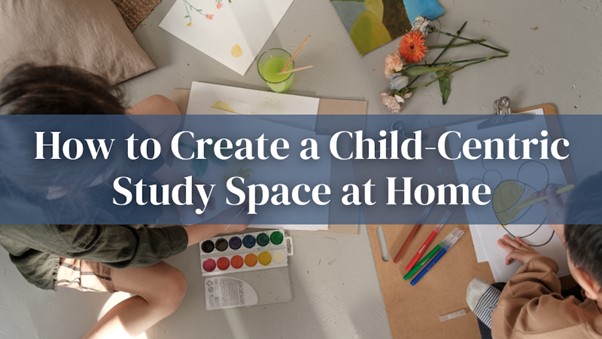Amidst today’s era of remote education and homeschooling, it’s crucial to create an environment that fosters your child’s concentration and productivity. A carefully curated study area has the power to ignite curiosity, enhance focus, and pave the way for academic triumph. Here’s a comprehensive guide to assist you in creating a study sanctuary at home, customized to meet your child’s needs, ensuring their optimal growth and success in education.
In the dynamic landscape of modern education, where the home doubles as the classroom, the significance of a child-centric study space cannot be overstated. By delving into the intricacies of crafting an environment conducive to learning, parents can cultivate a setting that not only supports their child’s academic journey but also inspires a lifelong love for learning. Through thoughtful consideration of factors such as location, comfort, personalization, and technology integration, parents can orchestrate a space where their child can flourish intellectually, nurturing a sense of autonomy and enthusiasm for knowledge acquisition.
Table of Contents
Understanding the Needs of Your Child:
Before embarking on the creation of your child’s study area, it’s essential to grasp their individual likes and needs. Take into account factors like their age, preferred method of learning, and any specific challenges they might face. While some kids excel in a serene, solitary setting, others may find inspiration in a lively, engaging environment. It’s important to tailor the study space at home to suit your child’s personality and learning style, ensuring they feel comfortable and motivated to explore their academic pursuits fully. As you set up this dedicated area for learning, consider how you can further enhance their educational experience. One valuable resource to complement their studies is to find an online math tutor. With personalized guidance and support, your child can build confidence and excel in mathematics, a fundamental subject crucial for academic success. Whether they need assistance with homework, concept clarification, or exam preparation, an online math tutor can provide targeted help tailored to your child’s specific needs.
Choosing the Right Location:
Selecting the ideal spot for your child’s study area is crucial for establishing an environment conducive to effective learning. Look for a peaceful corner in your house where distractions are minimal. Sunlight can significantly improve mood and focus, so aim for a location that receives ample natural light. Additionally, ensure the space is well-ventilated and kept tidy, free from unnecessary clutter. A calm and well-lit environment can set the stage for successful study sessions and help your child stay engaged and focused on their tasks.
Creating a Comfortable Environment:
Ensuring comfort is essential for keeping concentration levels high during study sessions. It’s worth investing in ergonomic furniture like a desk and chair that can be adjusted to support good posture and ward off any discomfort. Soft lighting choices, like desk lamps or overhead lights, are beneficial in alleviating eye strain. Furthermore, adding cozy touches such as cushions or rugs can create a welcoming atmosphere that encourages extended study sessions.
Incorporating Personalization and Inspiration:
Nurture your child’s imagination and drive by granting them the freedom to tailor their study area to their liking. Consider setting up a corkboard or whiteboard where they can proudly exhibit their artwork, uplifting quotes, or academic accomplishments. Integrate items that resonate with their passions, be it posters of beloved animals, literary heroes, or hobbies they adore. A study space that reflects their personality instills a deep sense of belonging and accomplishment, igniting their enthusiasm to fully immerse themselves in their educational pursuits.
Organizing Supplies and Resources:
Creating an orderly study environment is crucial for enhancing focus and productivity. It’s essential to ensure that all necessary supplies are readily available and neatly stored. Consider installing various storage options like shelves, drawers, and bins to keep everything organized and within reach. Designate specific areas for different items such as textbooks, notebooks, writing utensils, and electronic gadgets. Additionally, a systematic filing system for papers and assignments should be established to maintain tidiness and prevent the accumulation of clutter. By implementing these organizational strategies, you can create an efficient study space that fosters concentration and academic success.
Integrating Technology Wisely:
In today’s educational landscape, technology stands as a powerful ally, yet its unchecked use can easily derail focus. It’s crucial to establish well-defined boundaries regarding tech usage during study hours. Creating a designated space solely for electronic gadgets like laptops or tablets can help delineate between study time and leisure. Additionally, incorporating parental control software can serve as a safeguard against the allure of distracting websites and applications.
Furthermore, advocating for the integration of educational apps and online resources can significantly enrich your child’s learning experience. These tools serve not only to complement classroom teachings but also to sharpen academic skills. By steering them towards purposeful digital engagement, you equip them with the tools to navigate the digital realm responsibly and productively.
Promoting a Positive Learning Atmosphere:
The atmosphere within the study area ought to cultivate a feeling of peace and concentration. You might want to introduce natural elements like potted plants or artwork inspired by nature to establish a serene setting. Soft melodies or gentle ambient sounds can help drown out disturbances from the outside and enhance focus. It’s also beneficial to schedule periodic breaks during study sessions to prevent exhaustion and sustain efficiency.
Encouraging Collaboration and Interaction:
While it’s important for children to learn independently, their academic growth can be greatly enriched through collaboration and peer interaction. Allocate a section of the study area specifically for group tasks and conversations. Make sure there are cozy seating arrangements like bean bags or floor cushions to encourage comfortable group work sessions. Encourage your child to organize study gatherings with friends at home or join online study groups to share insights and viewpoints. This collaborative approach not only fosters a sense of camaraderie but also promotes a deeper understanding of the subject matter through collective learning experiences.
Evaluating and Adjusting as Needed:
A study area tailored to your child’s needs is not set in stone; it adapts as your child grows and their preferences shift. It’s essential to consistently evaluate how well the space is working for your child and ask for their input. Stay open-minded and ready to tweak things as needed, whether it means rearranging furniture, refreshing the decor, or introducing new educational resources and technology. By staying attuned to your child’s evolving requirements, you can ensure that their study space remains a dynamic and supportive environment for learning and growth.
Conclusion:
Crafting a study area tailored to your child’s needs is a deliberate endeavor that requires insight into their individual preferences and learning methods. It’s about more than just finding a spot; it’s about creating an atmosphere conducive to concentration and growth. Consider the ambiance, the seating arrangements, and the accessibility of supplies. Personalization is key; let your child’s interests and passions shine through in the decor and layout. Encourage positivity and productivity by establishing routines and boundaries around study time. By investing time and effort into curating a space that nurtures curiosity and fosters academic development, you’re setting the stage for a lifetime of learning and achievement. Remember, the goal isn’t just to create a study space—it’s to cultivate an environment where exploration, imagination, and success can thrive.
FAQs
1. What factors should I consider when creating a child-centric study space at home?
- When designing a study space at home for your child, consider factors such as their age, learning style, and personal preferences. Take into account the location of the study area within your home, the availability of natural light, and the level of noise and distractions in the vicinity.
2. How can I personalize the study space to cater to my child’s interests?
- Personalization is essential for creating a study space that resonates with your child. Incorporate elements such as posters, artwork, or decorations related to their hobbies, favorite subjects, or aspirations. Allow them to choose the colors, furniture, and accessories that reflect their personality and style.
3. What furniture and equipment are essential for a child-centric study space at home?
- Invest in ergonomic furniture, such as a comfortable chair and adjustable desk, to promote good posture and prevent discomfort during long study sessions. Ensure that the study area is equipped with adequate lighting, storage solutions for organizing supplies, and necessary technology such as a computer or tablet.




